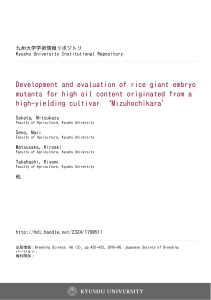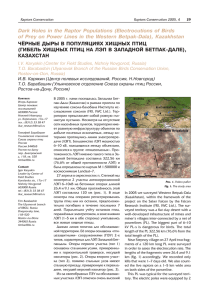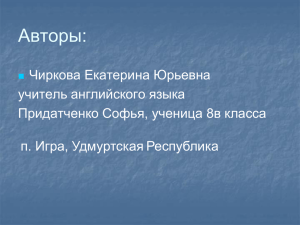
http://informahealthcare.com/cot ISSN: 1556-9527 (print), 1556-9535 (electronic) Cutan Ocul Toxicol, Early Online: 1–5 ! 2014 Informa Healthcare USA, Inc. DOI: 10.3109/15569527.2014.948685 RESEARCH ARTICLE Health threat associated with Caucasian giant hogweeds: awareness among doctors and general public in Poland Cutaneous and Ocular Toxicology Downloaded from informahealthcare.com by Nyu Medical Center on 07/24/15 For personal use only. Piotr Rzymski1, Piotr Klimaszyk2, Barbara Poniedziałek1, and Jacek Karczewski1 1 Department of Biology and Environmental Protection, Poznan University of Medical Sciences, Rokietnicka, Poznań, Poland and 2Department of Water Protection, Adam Mickiewicz University, Umultowska, Poznań, Poland Abstract Keywords Context: The Caucasian giant hogweeds (Heracleum sosnowskyi and H. mantegazzianum) are aggressive invaders successfully spreading across different parts of Europe. Their sap containing linear furanocoumarins can lead to a persisting cutaneous dermatitis and massive skin necrosis. Objective: We aimed to assess the awareness of the giant hogweeds’ threat among physicians and general public in Poland. Methods: The level of awareness was assessed using a short questionnaire given to different groups of physicians: dermatologists (DMs), general practitioners (GPs) and occupational practitioners (OPs). An independent questionnaire was also addressed to the general public. Results: Among the surveyed physician groups, DMs were the best informed, while OPs were the worst informed on health threats associated with the giant hogweeds and treatment methods. Most frequently, application of topical corticosteroids was indicated as a successful method of treatment following the exposure to hogweeds. In the general public, awareness was relatively low with only 57.7% of the surveyed having ever heard about these plants. TV, press and Internet were among the most frequent sources of information in this regard. Conclusions: Public and medical attention needs to be raised as to the threats associated with giant hogweeds, particularly in countries that are highly infested with these plants. Giant hogweeds, photodermatosis, phototoxicity, public awareness Introduction The natural environment has been known to be a prolific source of various potentially skin-sensitizing and allergyinducing agents1,2. Numerous plant parts and products have been implicated in contact dermatitis including species of the Heracleum genus (the Apiaceae family) – one of the main producers of linear furanocoumarins of the psoralens group. Potential dermal sensitizing compounds have been identified in, e.g. H. pinnatum C. B. Clarke and H. canescens Lindl. in Royle3, H. sphondylium L.4, and H. laciniatum Horn5. Nevertheless, the most serious health threats are associated with two closely related species, H. sosnowskyi Manden and H. mantegazzianum, generally known under a common name of the giant hogweeds6. However, there is genetic evidence that H. sosnowskyi and H. mantegazzianium are separate species7; both of them look very similar and considering the morphological features some botanists have even suggested that H. sosnowskyi might only be a sub-taxon of H. mantegazzianum. This has led to numerous Address for correspondence: Piotr Rzymski, Department of Biology and Environmental Protection, University of Medical Sciences, Rokietnicka 8, 60-806 Poznań, Poland. Tel/Fax: +48 61 854 7651. E-mail: rzymskipiotr@ump.edu.pl History Received 17 June 2014 Accepted 22 July 2014 Published online 14 August 2014 misunderstandings and confusions as well as the exclusion of H. sosnowskyi from the floristic lists of invasive species in some West European countries8. Giant hogweeds owe their name to their prominent size. They can grow up to 3 to 5 m in height and form very firm roots, whereas their white or pinkish flowers are clustered in an umbrella-shaped head of up to 50 cm wide. Native to the Western Caucasus (Western Georgia), they came to be promoted in the twentieth century in many European countries, including Poland, Latvia, Estonia, Lithuania, Belarus, Ukraine and Germany, due to their significant biomass production and potential use as a cattle feed6,8. Eventually, hogweed plantations were abandoned but the plants continued to spread, invading the natural environments and decreasing the local biodiversity9,10. Their stands are usually formed in moist habitats such as streams or canal banks, although they have also been reported across inhabited areas, along railways, on roadsides as well as along agricultural fields and ditches8,11,12. Giant hogweeds are widely distributed in Europe, including Poland, and the number of their stands has rapidly been growing in the last decades6,9,13. As the control of hogweed expansion requires adopting a multi-strategic, long-term and expensive approach, it is rather reasonable to expect an increased risk of exposure in the Polish population. 2 P. Rzymski et al. Cutaneous and Ocular Toxicology Downloaded from informahealthcare.com by Nyu Medical Center on 07/24/15 For personal use only. Figure 1. Photosensitizing agents found in giant hogweeds’ sap: 5-methoxypsoralen (A) and 8-methoxypsoralen (B). The crucial health threat associated with giant hogweeds is caused by their sap. It is known to contain significant concentrations of several photosensitizing psoralens, particularly 5-methoxypsoralen (5-MOP) and 8-methoxypsoralen (8MOP) (Figure 1). These compounds are usually present in all parts of the plant, including the hollow hairs. Their concentrations may vary depending on a season, environmental conditions and stress exposure14–17. Psoralens are soluble in lipids and can easily penetrate into epidermis. Once activated by ultraviolet A radiation (315—400 nm), they can lead to serious phytophotodermatitis18. The reaction occurs within 15 min after exposure with a sensitivity peak between 30 min and two hours. Activated psoralens bind to RNA and nuclear DNA (forming mono- and bi-adducts with pyrimidine bases), increasing cells’ oxidative stress and consequently damaging the cells’ membranes and oedema. It has been observed that the heat and moisture (sweat or dew) can aggravate these reactions. Inflammation of skin manifests through painful blisters and erythema that are visible maximally 48 h after exposure and can last in the form of dark pigmented spots or scars for several months, and in some cases – for several years. The affected areas may remain sensitive to ultraviolet irradiation6,19,20. In extreme cases, massive and expanding necrosis of skin can occur and require urgent surgical treatment with amputation being the most radical medical intervention21,22. The clinical image following the exposure to giant hogweeds results from different factors such as: (i) time of exposure; (ii) meteorological conditions (sunlight, temperature and humidity); (iii) concentration of psoralens in the sap; and (iv) individual susceptibility. This study was aimed to evaluate the awareness of giant hogweeds among physicians of different professions in Poland. Using a short questionnaire, we have surveyed dermatologists, general and occupation practitioners, as these are the three major groups of medical professionals who may have contact with patients affected by giant hogweeds. Moreover, we have also evaluated the general awareness of giant hogweeds in the general public in Poland. Materials and methods The survey included two groups of individuals: physicians and general population. The groups were given a short, anonymous questionnaire composed of questions on giant hogweeds, their appearance, health threats and treatment methods. Additionally, physicians were also asked to describe their professional experience with giant hogweeds, whereas general public was asked to indicate the main sources of Cutan Ocul Toxicol, Early Online: 1–5 knowledge on giant hogweeds and their previous exposure to these plants. The questionnaire was sent to a total of 677 Polish physicians of three medical professions: general practitioners (GPs), occupational practitioners (OPs) and dermatologists (DMs). Despite a relatively large number of questionnaires mailed to physicians, only 21 DMs and GPs, and 20 OPs decided to complete and return it. The age ranges of the interviewed groups were 32–63 (GPs), 32–61 (OPs) and 28– 56 (DMs). Additionally, the questionnaire was addressed to the general public of Wielkopolska region in Poland and was completed by a total of 111 individuals. The age range of that group was 20–81 (mean 48.5); female constituted 52.7%, male – 47.3%; tertiary education was represented by 52.7%, secondary – 34.5%, vocational – 12.7%. Among the surveyed, 47.3% lived in the city of4500 000 residents, 8.2% in the city of 100 000–500 000 residents, 21.8% in the city 10 000– 100 000 residents, while 22.7% lived in the city below 10 000 residents. The groups were broken down by professions, as follows: medical (38.8%), education (18.8%), farming (6.3%) and other (40.1%). Profession was not reported by 38.8% of the surveyed. The statistical analyses were performed using the Statistica v.10.0 software package (StatSoft, Tulsa, OK). Pearson’s chisquare test was used to compare the frequencies of the answers among the different groups. The relation between the age of the surveyed and the answers given in dichotomous questions (yes/no) was examined using a non-parametric Mann–Whitney U test. p Value50.05 was considered as statistically significant. Results Physicians The surveyed demonstrated different levels of awareness, depending on which physicians’ group they belonged to. Generally, DMs and GPs demonstrated greater knowledge on giant hogweeds than OPs. The majority of DMs (90.5%) and GPs (85.7%) have heard about giant hogweeds and declared to recognize their appearance (85.5% and 76.2%, respectively). When compared, OPs were significantly less informed (p50.05 in both cases). Some 55.0% of OPs have heard about these plants, whereas only 22.8% indicated to recognize their morphology. DMs and GPs acknowledged that giant hogweeds represent a serious health threat in Poland (76.2 and 71.4%, respectively), which was more often than in the case of OPs (50.0%). Moreover, OPs demonstrated significantly poorer knowledge on the potential hazard of exposure to these plants when compared to DMs and GPs (p50.01). Only 45% of OP was able to indicate any harmful effects of exposure to giant hogweed (Figure 2). Only 40.3% of the surveyed physicians had any knowledge on potential treatment methods for giant hogweed exposure. DMs largely prevailed in that group (65.4%), followed by GPs (23.1%) and OPs (11.5%). Generally, the application of topical and oral steroids, histamine antagonists, and soothing creams were suggested (Table 1). No relations between the age of the surveyed and the answers were found, regardless of the group of physicians (p40.05 in all cases). Hogweeds awareness: physicians and general public Cutaneous and Ocular Toxicology Downloaded from informahealthcare.com by Nyu Medical Center on 07/24/15 For personal use only. DOI: 10.3109/15569527.2014.948685 3 Figure 2. Health threats associated with exposure to giant hogweeds indicated by surveyed groups of physicians. Figure 3. Sources of knowledge on giant hogweeds among the general public in Poland. Table 1. Treatments in giant hogweed exposure as indicated by surveyed physicians. most frequent sources of information on giant hogweeds for the surveyed group (Figure 3). [%] Topical corticosteroids Histamine antagonists Oral steroids Soothing and regenerating creams Antibiotics Non-steroidal anti-inflammatory creams Antiseptics Discussion All combined DM GP OP 72.0 48.0 44.0 40.0 20.0 12.0 94.1 52.4 29.4 41.2 29.4 5.9 33.3 50.0 66.0 50.0 0.0 33.0 0.0 0.0 0.0 0.0 33.3 0.0 8.0 11.8 0.0 66.0 General public Over half of the surveyed (57.7%) declared to have heard about giant hogweeds. The appearance of the plants (confirmed by giving a correct description) was recognized by 68.8% of the surveyed, whereas 39.1% had come across the plant stands at least once in their life. Health threats were recognized by 73.4% (42.3% of all surveyed) and included: skin burns (92.0%), death (16.0%), skin allergy (12.0%), skin wounds (10.0%), eye irritation (2.0%) and skin necrosis (2.0%). The minority of the surveyed that have heard about giant hogweeds indicated to have been exposed to giant hogweeds at least once (7.8%), whereas half of them claimed to know how to proceed after a direct contact with the plant. Among these, the majority (90.9%) indicated that they would seek medical help immediately. Only 6.0% indicated that they would wash their skin with water thoroughly and protect the skin from further light exposure. No significant differences in the answers were found in relation to age, education and sex (p40.05 in all cases). Moreover, there was no significant relation between professions and the answers, except for the fact that the individuals employed in education came across giant hogweed more frequently (p50.05). TV, press and Internet were among the Photodermatitis caused by the exposure to plants of Heracleum genus has been reported worldwide in both humans19–21,23,24 and animals25,26. Our study aimed to comprehensively investigate the level of awareness on giant hogweed health threats among different groups of medical practitioners and in the general public. As found, surveying medical physicians is a very difficult task. It suggests that medical doctors might be unwilling to report their lack of knowledge or interest in participating in the scientific study, and can be rather hard to recruit. The difficulty in convincing physicians to participate in survey research has also been noted in other studies27. Giant hogweeds represent an emerging health threat which requires evaluation in terms of plants distribution, methods of management and control, public awareness, prevention and medical treatment of psoralen-induced dermatitis. Programs dedicated to building adequate awareness of medical services and general public have already been implemented in countries such as the USA and can effectively reduce medical and social costs of injuries caused by exposure to giant hogweeds28. All groups of the surveyed physicians, i.e. DMs, OPs and GPs, had experience with patients exposed to giant hogweeds, with DMs examining the largest number of such individuals. Generally, all the surveyed recognized the main effect of exposure to this threat, which is photodermatitis. At the same time, a relatively high percentage of physicians, including DMs, indicated that giant hogweeds can induce photoallergic reactions. There is, however, a substantial difference between phototoxicity and photoallergy, and it requires a clear differentiation in order to avoid misunderstandings. While the photoallergic reactions depend on individual predisposition, involve specific immunological reactions, can be unpredictable and generally affect few individuals, phototoxicity affects all individuals exposed to some chemical agent with the outcome being predictable29. As far as giant Cutaneous and Ocular Toxicology Downloaded from informahealthcare.com by Nyu Medical Center on 07/24/15 For personal use only. 4 P. Rzymski et al. hogweeds are concerned, it needs to be clarified that psoralens present in their sap are not photoallergic but phototoxic agents and will cause skin burn in all individuals exposed under favorable conditions: UV-A irradiance and humidity17. Among other symptoms indicated by the surveyed physicians, death resulting from giant hogweed exposure was never described in the literature. Surprisingly, none of the surveyed mentioned potential skin necrosis which, as reported, can lead to secondary bacterial infections and consequently to the amputation of limb22. It is clear that giant hogweeds exposure requires a proper management and treatment. At the same time, the surveyed physicians indicated methods of treatment which were limited to the use of different drugs and topical creams. If a patient is treated shortly after the exposure, it is essential to wash the exposed skin thoroughly with a soap and cold water as soon as possible to remove sap remnants and inhibit the photosensitizing reactions. Moreover, the skin should be protected from sunlight, for at least 48 h following the exposure, even if asymptomatic. If, for some reason, it is physically impossible, the use of sunscreen is highly recommended. Swelling and inflammatory reactions can be at least partially inhibited by application of ice pack or wet compresses20,30. As indicated by some authors, daily use of silver sulphadiazine was also found to be a safe and effective treatment of the affected areas19,21. None of these procedures were however reported by the physicians surveyed in our study. Instead, the use of topical corticosteroids was suggested, predominantly by DMa, a group generally representing the highest level of knowledge on giant hogweeds threats and having the broadest experience with exposures to the plants. As found by some authors, treating the affected areas with steroid creams (e.g. 1% hydrocortisone) may intensify the erythemic vesiculobullous rash after its application22. Therefore, this method may be insufficient, causing adverse side effects and if possible, is recommended to be omitted. Anti-histamines suggested by some of surveyed DMs, GPs and OPs may be useful in treatment since an intense itching of exposed skin can occur19,20. It is worth noting that the cases of exposure to giant hogweeds and their subsequent treatments are rarely provided in the literature23,31. Altogether, it highlights the need to increase a general awareness among physicians, particularly in countries highly invaded by giant hogweed species. Awareness among the general public also needs to improve. Invasive species such as giant hogweeds represent a group of ‘‘special care’’ because their toxicity may not be fully established while at the same time they can attract attention with their size and unusual appearance. This is particularly important in children who were found to be playing with stems of giant hogweeds and suffer from serious dermatitis afterwards32,33. In our study, over 45% of the surveyed have never heard of giant hogweeds and were unaware of the threats. This strongly highlights the need to implement social campaigns raising public awareness. To be most effective, those should involve all possible media, including TV, Internet and press, which were indicated as the primary sources of knowledge on giant hogweeds. Cutan Ocul Toxicol, Early Online: 1–5 Acknowledgements We wish to express our gratitude to all participants of the study. We would like to thank Ms. Iwona SzpakowskaRzymska for her help with collecting the completed questionnaire forms. Declaration of interest The authors report no declarations of interest. References 1. Uter W, Johansen JD, Börje A, et al. Categorization of fragrance contact allergens for prioritization of preventive measures: clinical and experimental data and consideration of structure-activity relationships. Contact Dermatitis 2013;69:196–230. 2. Rzymski P, Poniedziałek B. Dermatotoxins synthesized by bluegreen algae (Cyanobacteria). Post Dermatol Alergol 2012;29: 47–50. 3. Kumar R, Banerjee SK, Handa KL. Coumarins of Heracleum canescens and Heracleum pinnatum. Sources for dermal photosensitizing agents. Planta Medica 1976;30:291–294. 4. Weimarck G, Nilsson E. Phototoxicity in Heracleum sphondylium. Planta Medica 1980;38:97–111. 5. Kavli G, Midelfart K, Raa J, Volden G. Phototoxicity from furocoumarins (psoralens) of Heracleum laciniatum in a patient with vitiligo. Action spectrum studies on bergapten, pimpinellin, angelicin and sphondin. Contact Dermatitis 1983;9:364–366. 6. Nielsen C, Ravn HP, Nentwig W, Wade PM. The giant hogweed best practice manual. Guidelines for the management and control of an invasive weed in Europe. Hørsholm, Denmark: Forest and Landscape; 2005. 7. Jahodová Š, Fröberg L, Pyšek P, et al. Taxonomy, identification, genetic relationships and distribution of large Heracleum species in Europe. In: Pyšek P, Cock MJW, Nentwig W, Ravn HP, eds. Ecology and management of giant hogweed (Heracleum mantegazzianum). Wallingford: CAB International; 2007:1–19. 8. Kabuce N, Priede N. [Internet]. Invasive alien species fact sheet. Heracleum Sosnowskyi. Online Database of the North European and Baltic Network on Invasive Alien Species – NOBANIS; 2010. Available from: http://www.nobanis.org/files/factsheets/Heracleum% 20sosnowskyi.pdf [last accessed 10 March 2014]. 9. Baležentien_e L, Bartkevičius E. Invasion of Heracleum sosnowskyi (Apiaceae) at habitat scale in Lithuania. J Food Agric Environ 2013;11:1370–1375. 10. Dostál P, Müllerová J, Pyšek P, et al. The impact of an invasive plant changes over time. Ecol Lett 2013;16:1277–1284. 11. Otte A, Franke R. The ecology of the Caucasian herbaceous perennial Heracleum mantegazzianum in cultural ecosystems of Central Europe. Phytocoenologia 1998;28:205–232. 12. Pysek P, Cock MJW, Nentwig W, Ravn HP. Ecology and management of giant gogweed (Heracleum mantegazziannum). Cambridge: CABI International; 2007. 13. Pyšek P, Chytrý M, Pergl J, et al. Plant invasions in the Czech Republic: current state, introduction dynamics, invasive species and invaded habitats. Preslia 2012;84:575–629. 14. Pira E, Romano C, Sulotto F, et al. Heracleum mantegazzianum growth phases and furocoumarin content. Contact Dermatitis 1989;21:300–303. 15. Zobel AM, Brown SA. Seasonal changes of furanocoumarin concentrations in leves of Heracleum lanatum. J Chem Ecol 1990; 16:1623–1634. 16. Zobel AM, Crellin J, Brown SA, Glowniak K. Concentrations of furanocoumarins under stress conditions and their histological localization. Acta Hortic Wageningen 1994;381:510–516. 17. Page NA, Wall RE, Darbyshire SJ, Muligan GAS. The biology of invasive alien plants in Canada 4. Heracleum mantegazzianum. Can J Plant Sci 2006;86:569–589. 18. Knudsen EA, Kroon S. In vitro and in vivo phototoxicity of furocoumarin-containing plants. Clin Exp Dermatol 1988;13: 92–96. DOI: 10.3109/15569527.2014.948685 Cutaneous and Ocular Toxicology Downloaded from informahealthcare.com by Nyu Medical Center on 07/24/15 For personal use only. 19. Lagey K, Duinslaeger L, Vanderkelen A. Burns induced by plants. Burns 1995;21:542–543. 20. Langley DM, Criddle LM. A 43-year-old woman with painful, vesicular lesions from giant hogweed photodermatitis. J Emerg Nurs 2006;32:246–248. 21. Chan JC, Sullivan PJ, O’Sullivan MJ, Eadie PA. Full thickness burn caused by exposure to giant hogweed: delayed presentation, histological features and surgical management. J Plast Reconstr Aesthet Surg 2011;264:128–130. 22. Klimaszyk P, Klimaszyk D, Piotrowiak M, Popiołek A. Unusual complication after occupational exposure to Giant hogweed (Heracleum mantegazzianum): case report. Int J Occup Med Environ Health 2014;27:141–144. 23. Karimian-Teherani D, Kinaciyan T, Tanew A. Photoallergic contact dermatitis to Heracleum giganteum. Photodermatol Photoimmunol Photomed 2008;24:99–101. 24. Probert SM, Lacey J, Gautam S. Giant hogweed burns. Arch Dis Child 2013;98:544. Hogweeds awareness: physicians and general public 5 25. Andersen UV, Calov B. Long-term effects of sheep grazing on giant hogweed (Heracleum mantegazzianum). Hydrobiologia 1996;340:227–284. 26. Dolowy WC. Giant hogweed photodermatitis in two dogs in Bellevue, Washington. J Am Vet Med Assoc 1996;209:722. 27. Asch S, Connor SE, Hamilton EG, Fox SA. Problems in recruiting community-based physicians for health services research. J Gen Intern Med 2000;15:591–599. 28. Kraus N. Giant hogweed program 2012 annual report. New York: New York State Department of Environmental Conservation; 2012. 29. Spiewak R. The substantial differences between photoallergic and phototoxic reactions. Ann Agric Environ Med 2012;19:888–889. 30. Northall, F. Vegetation, vegetables, vesicles: plants and skin. Emerg Nurse 2003;11:18–23. 31. Jakubowicz O, Z_ aba C, Nowak G, et al. Heracleum Sosnowskyi Manden. Ann Agric Environ Med 2012;19:327–328. 32. Smellie JH. Giant hogweed. Brit Med J 1968;5610:123. 33. Drever JC, Hunter JAA. Giant hogweed dermatitis. Scott Med J 1970;15:315–319.



